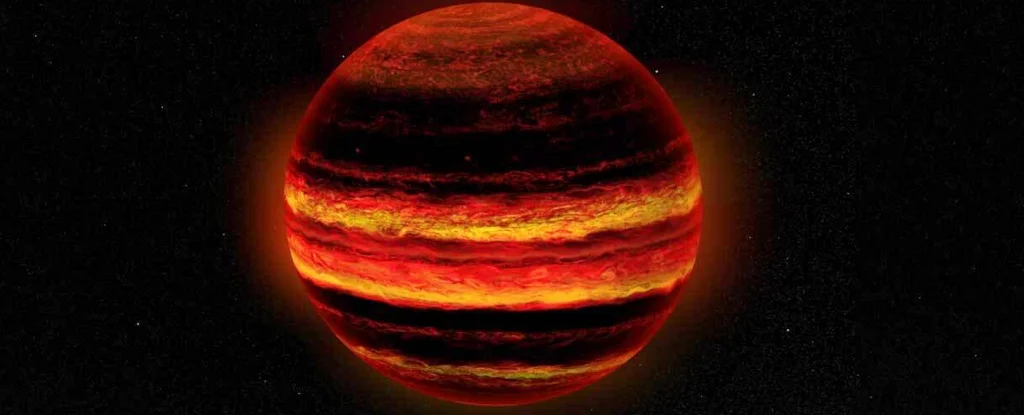Illustrations of the Milky Way show a spiral structure of star-filled “arms” radiating from the centre. Similar formations are observed in the swirling masses of gas and dust surrounding some of the young stars that make up planetary systems.
These protoplanetary disks, which act as cradles for newborn planets, are of interest to researchers because they provide a window into both the early stages of our own solar system and planet formation in general. Scientists have long suspected that the spiral branches in these disks might originate from newly formed planets, but have not been detected until now.
In an article published in the journal Nature AstronomyResearchers at the University of Arizona reported the discovery of a giant exoplanet called MWC 758c that could form spiral arms in the newly emerged planetary system. University of Arizona astronomers also offer possibilities as to why scientists have tried to find this planet in the past and how their methods could be applied to find other hidden planets under similar conditions.
“Our work provides compelling evidence that these spiral arms originate from giant planets,” said Kevin Wagner, lead author of the paper and a postdoctoral fellow at the University of Arizona Steward Observatory. “And by looking for more planets like MWC 758c with the new James Webb Space Telescope, we’ll be able to further test and support this idea.”

The MWC 758 planetary system was observed in the infrared using the Large Binocular Telescope Interferometer (LBTI). Theoretical simulations suggest that the newly discovered planet “c” is most likely responsible for the spiral pattern in the disk of gas and dust surrounding the young star. Image copyright: K. Wagner et al.
The planet’s star is about 500 light-years from Earth and is only a few million years old; An embryo compared to our 4.6 billion year old Sun. So the system still has a protoplanetary disk because it takes about 10 million years for orbiting debris to be ejected from the system, absorbed by the star, or transformed into planets, moons, asteroids, and comets. A distinctive spiral pattern in the debris of this system was first discovered in 2013, and astronomers immediately drew attention to the connection with theoretical modeling of giant planet formation.
Also read – A giant black hole destroyed the star and hurled its debris into space
“I think of this system as an analogy for what our own solar system would look like less than 1 percent of the time,” Wagner said. “Jupiter, a giant planet, probably also interacted with our own disk billions of years ago and gravitationally shaped it, eventually leading to the formation of Earth.”
Astronomers have imaged many of the protoplanetary disks in star systems that can be seen with modern telescopes. About one-third of the approximately 30 discs identified have spiral arms; there are visible vortices in the gas and dust particles of the disk.
“The spiral arms can provide feedback on the planet formation process itself,” Wagner said. “Our observations of this new planet support the idea that giant planets formed at an early stage, accumulating mass from the environment in which they were born, and then forming other, smaller planets by gravitationally changing the later environment.”
The spiral arms are formed by the gravitational effect of the orbital mate on the material orbiting the star. In other words, the presence of a very large companion, such as a giant planet, must have caused the spiral pattern in the disk. But previous attempts to identify the responsible planet have so far been fruitless.
Large Binocular Telescope in Arizona. The LBTI instrument combines infrared light from both 8.4-metre mirrors to image planets and disks around young and nearby stars. Image credit: D. Steele, Large Binocular Telescope Observatory
“It was an open question why we haven’t seen any of these planets yet,” Wagner said. “Most models of planet formation suggest that giant planets must have been very bright soon after they formed, and such planets should have been detected already.”
The UArizona researchers were finally able to detect the MWC 758c with the Large Binocular Telescope Interferometer, or LBTI, a UArizona instrument that connects the telescope’s two 8.4-metre primary mirrors, capable of observing at longer wavelengths in the mid-infrared, unlike most other instruments used. For observing exoplanets at shorter or bluer wavelengths. According to Steve Ertel, co-author of the paper and LBTI principal investigator, the device has a camera that can detect infrared light, similar to NASA’s James Webb Space Telescope (JWST).
Also read – NASA says a fleet of balloons could reveal Venus’ inner workings
Ertel said that although the exoplanet is estimated to be at least twice the mass of Jupiter, it cannot be seen by other telescopes due to its unexpected red color – the “redest” planet ever discovered. Due to the thermal glow of Earth’s atmosphere and the telescope itself, longer red wavelengths are more difficult to detect than shorter wavelengths. The LBTI is one of the most sensitive infrared telescopes ever made, and due to its larger size it can even outperform the JWST in detecting planets very close to their stars, such as MWC 758c.
“We propose two different models of why this planet is brighter at longer wavelengths,” Ertel said. said. “Either a planet with a lower-than-expected temperature, or a planet still hot from the time it formed and covered with dust.”
“If there is a lot of dust around this planet, the dust will absorb shorter wavelengths or blue light, causing the planet to appear bright only at longer and redder wavelengths,” said co-author Caitlin Cratter, a theoretical astrophysicist at the University of California. in Arizona. “In another scenario, a colder planet surrounded by less dust makes the planet dimmer and emits more light at a longer wavelength.”
Wagner said the abundance of dust around the planet could indicate that the planet is still forming and may be in the process of forming a system of Jupiter-like moons around Jupiter. On the other hand, if a planet is following a cooler pattern, something may be going on in these early star systems that is causing planets to form colder than expected, prompting planetary scientists to reconsider their planet formation models and exoplanet exploration strategies.
“In any case, we now know that we should start looking for redder protoplanetaries in these systems with spiral arms,” Wagner said. said.
Also read – Rocket Lab’s 40th mission begins with a reusable engine
When astronomers at the University of Arizona observe the giant exoplanet with the James Webb Space Telescope, they hope to deduce which of two scenarios is occurring in the nucleation system. The team was given time to use the JWST in early 2024 to complete these observations.
“Based on the results of the JWST observations, we could begin to apply this new knowledge to other star systems,” Wagner said, “which will allow us to make predictions and give us an idea of where other hidden planets might be hiding.” What features do we need to look for in order to discover them?














